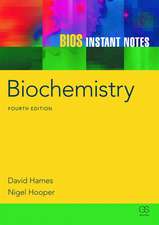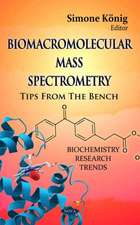Muscle Physiology and Biochemistry: Developments in Molecular and Cellular Biochemistry, cartea 31
Autor Shoichi Imai, Makoto Endo, Iwao Ohtsukien Limba Engleză Hardback – 30 iun 1999
| Toate formatele și edițiile | Preț | Express |
|---|---|---|
| Paperback (1) | 931.20 lei 43-57 zile | |
| Springer Us – 8 noi 2012 | 931.20 lei 43-57 zile | |
| Hardback (1) | 1049.09 lei 38-44 zile | |
| Springer Us – 30 iun 1999 | 1049.09 lei 38-44 zile |
Din seria Developments in Molecular and Cellular Biochemistry
- 5%
 Preț: 382.69 lei
Preț: 382.69 lei - 24%
 Preț: 1056.97 lei
Preț: 1056.97 lei - 18%
 Preț: 1203.04 lei
Preț: 1203.04 lei - 24%
 Preț: 1060.04 lei
Preț: 1060.04 lei -
 Preț: 397.53 lei
Preț: 397.53 lei - 5%
 Preț: 365.10 lei
Preț: 365.10 lei - 18%
 Preț: 1529.23 lei
Preț: 1529.23 lei - 5%
 Preț: 722.21 lei
Preț: 722.21 lei - 24%
 Preț: 1568.12 lei
Preț: 1568.12 lei - 24%
 Preț: 1580.08 lei
Preț: 1580.08 lei - 24%
 Preț: 1584.02 lei
Preț: 1584.02 lei - 5%
 Preț: 359.51 lei
Preț: 359.51 lei - 24%
 Preț: 1564.06 lei
Preț: 1564.06 lei - 24%
 Preț: 1077.72 lei
Preț: 1077.72 lei - 15%
 Preț: 572.80 lei
Preț: 572.80 lei - 24%
 Preț: 1583.80 lei
Preț: 1583.80 lei - 5%
 Preț: 659.96 lei
Preț: 659.96 lei - 18%
 Preț: 1201.98 lei
Preț: 1201.98 lei - 24%
 Preț: 801.38 lei
Preț: 801.38 lei - 24%
 Preț: 1098.57 lei
Preț: 1098.57 lei - 18%
 Preț: 924.22 lei
Preț: 924.22 lei - 24%
 Preț: 1060.10 lei
Preț: 1060.10 lei - 5%
 Preț: 1003.85 lei
Preț: 1003.85 lei - 18%
 Preț: 919.87 lei
Preț: 919.87 lei - 5%
 Preț: 1394.53 lei
Preț: 1394.53 lei - 24%
 Preț: 795.19 lei
Preț: 795.19 lei - 18%
 Preț: 931.20 lei
Preț: 931.20 lei - 15%
 Preț: 632.17 lei
Preț: 632.17 lei - 24%
 Preț: 808.09 lei
Preț: 808.09 lei - 18%
 Preț: 935.24 lei
Preț: 935.24 lei
Preț: 1049.09 lei
Preț vechi: 1380.37 lei
-24% Nou
Puncte Express: 1574
Preț estimativ în valută:
200.83€ • 206.55$ • 166.61£
200.83€ • 206.55$ • 166.61£
Carte tipărită la comandă
Livrare economică 12-18 februarie
Preluare comenzi: 021 569.72.76
Specificații
ISBN-13: 9780792382645
ISBN-10: 0792382641
Pagini: 206
Ilustrații: V, 206 p.
Dimensiuni: 210 x 279 x 14 mm
Greutate: 0.63 kg
Ediția:1999
Editura: Springer Us
Colecția Springer
Seria Developments in Molecular and Cellular Biochemistry
Locul publicării:New York, NY, United States
ISBN-10: 0792382641
Pagini: 206
Ilustrații: V, 206 p.
Dimensiuni: 210 x 279 x 14 mm
Greutate: 0.63 kg
Ediția:1999
Editura: Springer Us
Colecția Springer
Seria Developments in Molecular and Cellular Biochemistry
Locul publicării:New York, NY, United States
Public țintă
ResearchCuprins
Professor Ebashi’s impact on the study of the regulation of striated muscle contraction.- Troponin I: Inhibitor or facilitator.- Calcium ion regulation of muscle contraction: The regulatory role of troponin T.- Thermodynamic analyses of calcium binding to troponin C, calmodulin and parvalbumins by using microcalorimetry.- A strange calmodulin of yeast.- Regulation by molluscan myosins.- The properties and function of invertebrate new muscle protein.- Actin binding proteins that change extent and rate of actin monomer-polymer distribution by different mechanisms.- A phosphorus-31 nuclear magnetic resonance study on the complex of chicken gizzard myosin subfragment 1 with adenosine diphosphate.- Interactions of protein phosphatase type 1, with a focus on myosin phosphatase.- Myosin light chain kinase from skeletal muscle regulates an ATP-dependent interaction between actin and myosin by binding to actin.- Ca2+-induced Ca2+ desensitization of myosin light chain phosphorylation and contraction in phasic smooth muscle.- Growing and differentiating characterization of aortic smooth muscle cell line, p53LMAC01 obtained from p53 knock out mice.- Expressional regulation of smooth muscle cell-specific genes in association with phenotypic modulation.- Roles of intracellular Ca2+ receptors in the pancreatic ß-cell in insulin secretion.- Organization of connectin/titin filaments in sarcomeres of differentiating chicken skeletal muscle cells.- Detection of a sequence involved in actin-binding and phosphoinositide-binding in the N-terminal side of cofilin.- Creatine kinase, cell membrane and Duchenne muscular dystrophy.- Structural basis of the function of endothelin receptor.- Stimulation of plasma membrane Ca2+-pump ATPase of vascular smooth muscle by cGMP-dependent proteinkinase: Functional reconstitution with purified proteins.- Chemical modification of an arginine residue in the ATP-binding site of Ca2+-transporting ATPase of sarcoplasmic reticulum by phenylglyoxal.- Intrinsic inhibitor of inositol 1,4,5-trisphosphate binding.- Dynamic regulation of intracellular calcium signals through calcium release channels.- Comparison of properties of Ca2+ release channels between rabbit and frog skeletal muscles.- Index to Volume 190.











